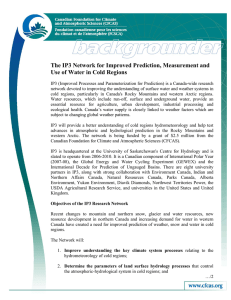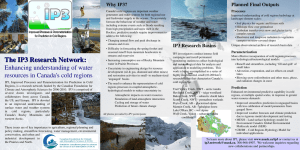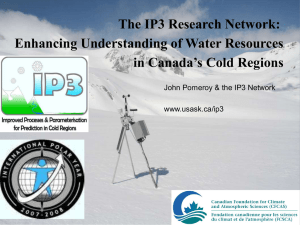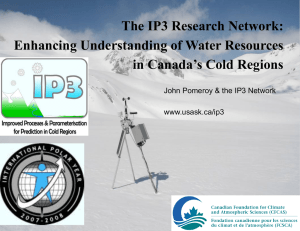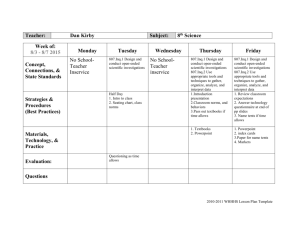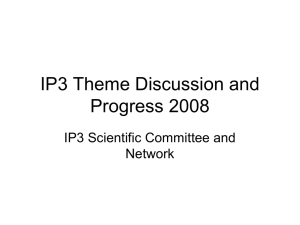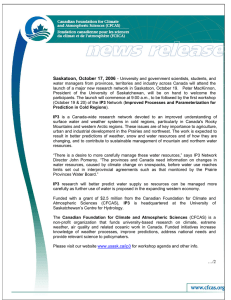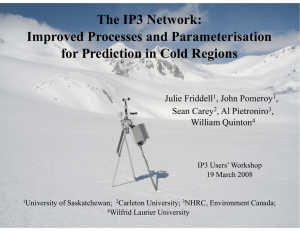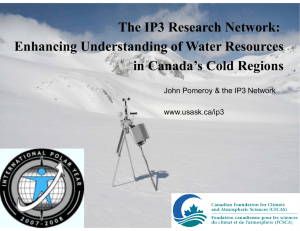www.usask.ca/ip3
advertisement
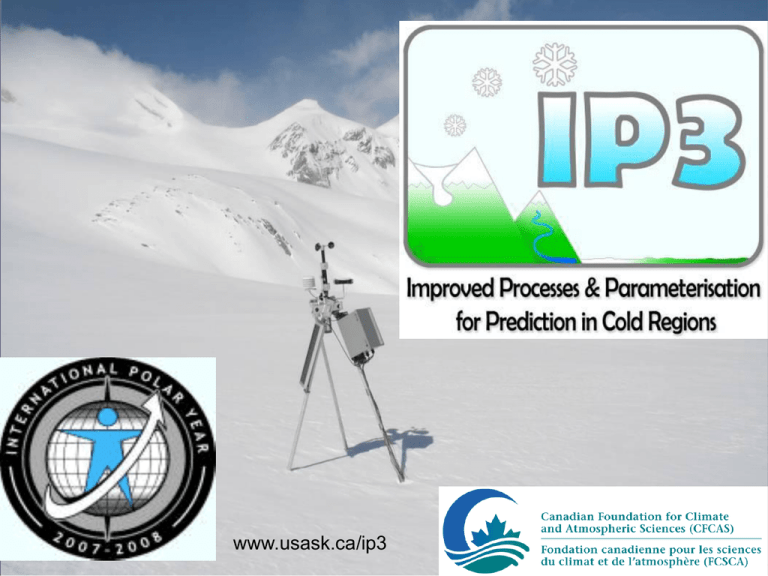
www.usask.ca/ip3 IP3... ...is devoted to understanding water supply and weather systems in cold Regions at high altitudes and high latitudes (Rockies and western Arctic) ...is contributing to better prediction of regional and local weather, climate, and water resources in cold regions, including ungauged basin streamflow, changes in snow and water supplies, and calculation of freshwater inputs to the Arctic Ocean ...is composed over about 50 investigators and collaborators from Canada, USA, UK, France, Germany, Italy, Austria, …runs from 2006-2011 Why IP3? Need to forecast changing flow regime of streams and rivers in the Western Cordillera and North Increasing consumptive use of Rocky Mountain water in Prairie Provinces Uncertainty in design for resource (oil & gas, diamond, forests etc) development and restoration activities in small to medium size, headwater ‘ungauged’ basins Opportunity to improve cold regions snow, ice, frost, soil and water processes in models to reduce predictive uncertainty in: Atmospheric impacts on snow, ice and water resources Simulation of land-cryosphere-atmosphere interaction Cycling and storage of water, snow and ice Prediction of future climate change IP3 Network Investigators Sean Carey, Carleton University Richard Essery, Edinburgh University Raoul Granger, Environment Canada Masaki Hayashi, University of Calgary Rick Janowicz, Yukon Environment Philip Marsh, University of Saskatchewan Scott Munro, University of Toronto Alain Pietroniro, University of Saskatchewan John Pomeroy (PI), University of Saskatchewan William Quinton, Wilfrid Laurier University Ken Snelgrove, Memorial University of Newfoundland Ric Soulis, University of Waterloo Chris Spence, University of Saskatchewan Diana Verseghy, Environment Canada (people in bold are on Scientific Committee, 48 SC meetings so far!) IP3 Collaborators Peter Blanken, University of Colorado Doug Clark, Centre for Ecology & Hydrology, UK Bruce Davison, McGill University/Env Canada Mike Demuth, Natural Resources Canada Vincent Fortin, MRD - Environment Canada Ron Goodson, HAL - Environment Canada Chris Hopkinson, Centre of Geographic Sciences, NS Tim Link, University of Idaho Newell Hedstrom, NWRI - Environment Canada Richard Heck, University of Guelph Joni Onclin, University of Saskatchewan Murray Mackay, CRD - Environment Canada Danny Marks, USDA - Agricultural Research Service Nick Rutter, University of Sheffield, UK Frank Seglenieks, University of Waterloo Mike Solohub, University of Saskatchewan Brenda Toth, HAL - Environment Canada Cherie Westbrook, University of Saskatchewan Jean Emmanuel Sicart, IRD France Stefan Pohl, Germany Bob Reid, Indian and Northern Affairs Canada Rob Schincariol, Univ. of Western Ontario Kevin Shook, University of Saskatchewan Uli Strasser, LMU, Munich, Germany Bryan Tolson, University of Waterloo Adam Winstral, USDA – ARS James Craig, University of Waterloo Steve Liang – University of Calgary IP3 Secretariat Centre for Hydrology, Univ. Sask., Saskatoon, Coldwater Centre, Univ Sask., Canmore UNBC, Prince George -Terrabyte Server for Data and Model -Archival Records -Website, FTP -CRHM repository -High Speed Link to NHRC HAL Computing Cluster Nadine Kapphahn: Network Manager, Secretary of SC, BOD & CHRUG, Outreach Coordinator Michael Allchin: Information and Data Manager Joni Onclin: Financial Manager Tom Brown: CRHM Modeller Muluneh Mekonnen: MESH Modeller Robert Sandford: Book Writer Julie Friddell, Steen Westergaard, Former Network Managers Edgar Herrera, Former GEM Modeller Chairman Woo Board of Directors Hok Woo (McMaster Univ)* Vincent Fortin (Env Canada) Dan Moore (UBC) Bob Reid (INAC) John Pomeroy (Univ Sask) CFCAS Representative IP3 Governance IP3 Science Focus Snow – redistribution, accumulation, sublimation, radiative transfer and melt Forests – effect on radiative and turbulent transfer to snow and frozen ground Glaciers - interactions with the atmosphere Frozen ground – freezing, thaw, water transmission and storage Lakes/Ponds – advection, atmospheric fluxes, heat storage, flow in drainage systems IP3 Scaling Methodology Resolution 1m Tile/HRU Point Prediction Terrestrial Open Water Snow and Ice Parametrization Terrestrial Open Water Snow and Ice Process Terrestrial Open Water Snow and Ice MODELS 100 m Landscape type Tile/HRU Hillslope 100 m - 2 km Pattern/tile Grid/small basin Sub-basin 2 - 10 km 10 km - Multi-grid/medium basin Multi-grid Basin Mesoscale 10 km Regional; Previous LSS Scaling Methodology IP3 Scaling Methodology MESH CHRM CHRM CHRM CEOP Hydrology Quinton CFCAS Study---------------> MESH MESH MESH CHRM CEOP Hydrology <----------------------------------MAGS Integrating the TOP DOWN and BOTTOM UP approaches IP3 – Goals and Theme Structure Theme 1 Processes: Advance our understanding of cold regions hydrometeorological processes Theme 2 Parameterisation Develop mathematical parameterisation of cold regions processes for small to medium scales Theme 3 Prediction Evaluate and demonstrate improved hydrological and atmospheric prediction at regional and smaller scales in the cold regions of Canada Ultimately – contribute to multiscale assessment of coupled climate system, weather and water resources in cold regions IP3 Research Basins Havikpak Creek, NT taiga woodland Wolf Creek, YT subarctic tundra cordillera Trail Valley Creek, NT arctic tundra Polar Bear Pass, NU arctic wetlands Baker Creek, NT subarctic shield lakes Peyto Glacier, AB glacierized alpine Scotty Creek, NT permafrost wetlands Lake O'Hara, BC wet alpine Reynolds Creek, Idaho mountain rangeland Marmot Creek, AB subalpine forest IP3 Final Outputs Improved understanding of cold regions hydrological processes at multiple scales Unique observational archive of research basin data More effective incorporation of cold regions processes and parameterisations into hydrological and meteorological models at regional and smaller scales – CRHM, MESH Improved environmental predictive capability in cold regions in response to greater water resource demands: Enhanced hydrological and atmospheric model performance at multiple spatial scales and at scales requested by users Improved streamflow prediction in ungauged basins with less calibration of model parameters from gauged flows Improved weather and climate prediction due to rigorous model development and testing IP3 Legacy Better understanding of cold regions hydrology and climate Development of network of instrumented research basins from Canadian Rockies to Arctic Trained cold regions hydrologists and climatologists Improved predictive models Cold regions hydrological models Coupled atmospheric-hydrological models Knowledge transfer to users Workshop results, presentations, papers Books Observational and model datasets
